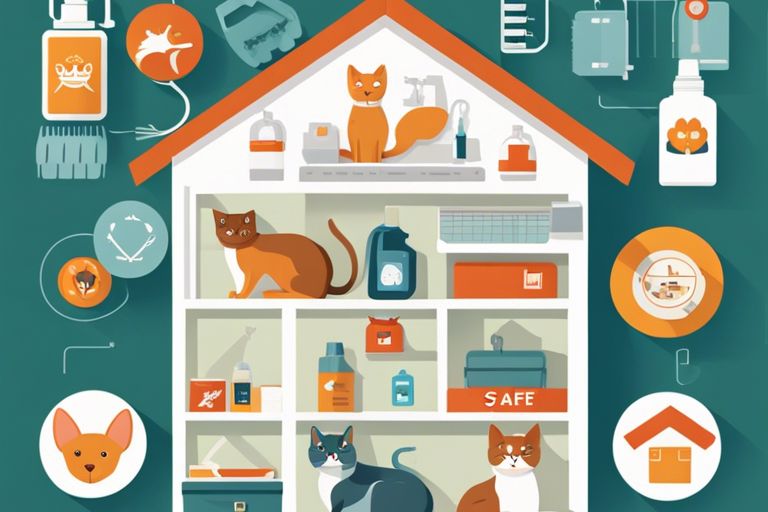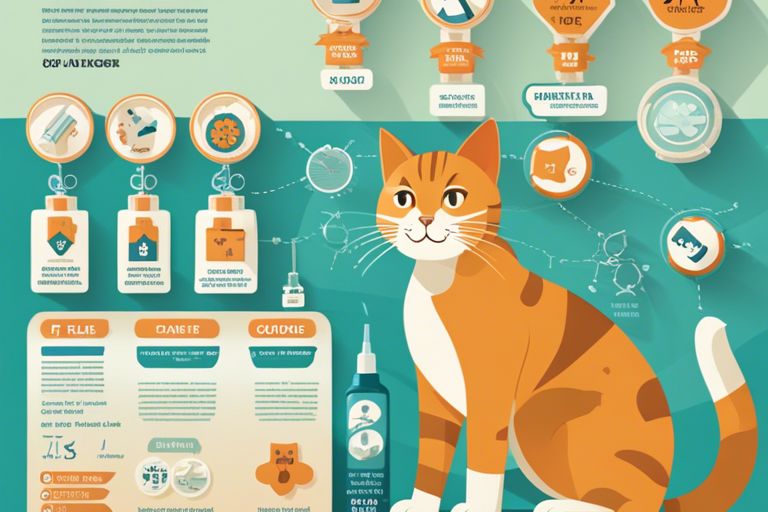Ensuring the health and well-being of your feline friend is essential, and preventing them from getting fleas and ticks is a crucial part of that. Not only can these parasites cause discomfort and irritation for your cat, but they can also transmit diseases and infections that can be harmful to both your pet and your family. In order to safeguard your cat from these pests, it’s essential to take proactive measures to prevent infestations. By following these tips and recommendations, you can help keep your cat healthy and happy, free from the threat of fleas and ticks.
Key Takeaways:
- Use flea and tick preventatives regularly: Consistently using flea and tick preventatives recommended by your veterinarian can help keep these parasites at bay.
- Maintain a clean environment: Regularly vacuuming, washing bedding, and keeping the outdoor area tidy can help reduce the likelihood of flea and tick infestations.
- Check your cat regularly: Regularly inspect your cat for any signs of fleas or ticks, especially after spending time outdoors.
- Keep your cat indoors: Limiting your cat’s exposure to outdoor environments can greatly reduce the risk of encountering fleas and ticks.
- Consult with your veterinarian: Your veterinarian can provide personalized recommendations and treatment options based on your cat’s specific needs and lifestyle.

Understanding Fleas and Ticks
Obviously, as a responsible pet owner, you want to do everything you can to keep your furry friend safe and healthy. One way to do that is by understanding the threat of fleas and ticks and taking steps to prevent them from infesting your cat. Fleas and ticks are external parasites that feed on the blood of animals and can transmit diseases, such as Lyme disease and Rocky Mountain spotted fever, to both pets and humans. These tiny pests can cause a lot of discomfort and potential health issues for your cat, so it’s important to be proactive in preventing them.
The Life Cycle of Fleas and Ticks
Understanding the life cycle of fleas and ticks is essential in preventing infestations. Fleas have a four-stage life cycle: egg, larva, pupa, and adult. They thrive in warm, humid environments and can lay up to 50 eggs per day, which can quickly lead to a full-blown infestation in your home. Ticks, on the other hand, have a three-stage life cycle: larva, nymph, and adult. They are commonly found in grassy or wooded areas and can latch onto your cat as it roams outdoors.
How Pets Contract Fleas and Ticks
It’s important to understand how your pets can contract fleas and ticks to effectively prevent infestations. Fleas can jump onto your cat from other infested animals or environments, such as grooming salons or boarding facilities. Ticks, on the other hand, attach themselves to your cat as it explores outdoor environments, such as tall grass or wooded areas. It’s essential to regularly check your cat for any signs of flea or tick infestation, particularly after spending time outdoors.
Preventative Measures
Even if your cat doesn’t have fleas or ticks, it’s important to take preventative measures to ensure they stay that way. By taking proactive steps, you can significantly reduce the chances of your cat becoming infested with these pesky parasites. For more information on protecting your cat from fleas, check out Protect Your Cat and Home from Fleas.
Regular Grooming and Inspections
Regular grooming and inspections play a crucial role in preventing fleas and ticks from infesting your cat. Brushing your cat regularly can help you detect any fleas or ticks before they become a major problem. Use a flea comb to check for any signs of infestation, including flea dirt or actual insects. By catching the problem early, you can prevent a full-blown infestation that could harm your cat.
Environmental Control Strategies
Implementing environmental control strategies in your home can greatly reduce the likelihood of your cat picking up fleas and ticks. Vacuuming and cleaning your home regularly, especially in areas where your cat spends the most time, can help eliminate any fleas or tick eggs before they have a chance to hatch. Additionally, consider using safe and effective flea control products in your home and yard to create a flea-free environment for your cat.
Treatment Options
Despite your best efforts to prevent fleas and ticks, your cat may still become infested. It’s important to address the issue promptly to prevent any potential health problems for your pet. There are several treatment options available to help you get rid of these pesky parasites and keep your cat healthy.
Topical Medications
Topical medications are one of the most common and effective ways to treat fleas and ticks on your cat. These medications are applied directly to the skin, usually on the back of the neck, and work by killing existing pests and preventing new infestations. Some topical medications are available over the counter, while others may require a prescription from your veterinarian. It’s important to follow the instructions carefully, as using too much or too little can be harmful to your pet. Be sure to choose a product specifically designed for cats, as some medications for dogs can be toxic to felines.
Oral Medications and Collars
If your cat is not a fan of topical treatments, oral medications and collars are viable alternatives. Oral medications can be given to your cat in the form of a pill or a flavored chew, and work by killing fleas and ticks from the inside out. Collars are worn around your cat’s neck and release a continuous low dose of medication to repel and kill parasites. Some oral medications can also prevent heartworm disease, so be sure to talk to your veterinarian about the best options for your cat. When using collars, it’s important to monitor your cat for any signs of irritation or discomfort, and adjust the fit if necessary.
Natural and Alternative Remedies
Not a fan of using chemical treatments to prevent fleas and ticks on your feline friend? There are several natural and alternative remedies that can help keep these pests at bay. While they may not be as potent as traditional medications, they can still be effective in combination with other preventive measures.
Herbal and Natural Preventatives
If you prefer using herbal and natural preventatives, there are several options available to you. Products containing essential oils such as lavender, cedar, eucalyptus, and lemongrass are known to have repellent properties against fleas and ticks. You can use these oils to make your own natural flea and tick spray or look for pre-made products specifically designed for cats. Just be sure to consult a veterinarian before using any essential oils on your cat, as some may be toxic to felines.
The Role of Diet and Nutrition in Prevention
Believe it or not, your cat’s diet and nutrition can play a role in preventing fleas and ticks. A well-balanced diet that includes essential fatty acids and key nutrients can help keep your cat’s skin and coat healthy, making it more difficult for pests to take hold. Additionally, incorporating supplements such as brewer’s yeast, garlic, or apple cider vinegar into your cat’s diet may help repel fleas and ticks. However, it’s important to note that excessive amounts of certain ingredients, such as garlic, can be toxic to cats, so be sure to talk to your veterinarian before making any dietary changes.
Preventing Fleas and Ticks in Your Cat
Now that you have learned about the various preventative measures against fleas and ticks, it is important to stay proactive in protecting your feline friend. By consistently using flea and tick preventative products, such as collars, topical treatments, and oral medications, you can minimize the risk of infestations. Additionally, regularly grooming and inspecting your cat for signs of fleas and ticks will allow you to catch any potential issues early on. Remember to also keep your living space clean and vacuum regularly to eliminate any potential flea habitats. By staying vigilant and incorporating these preventive measures into your routine, you can effectively protect your cat against fleas and ticks.
FAQ
Q: What are some effective ways to prevent my cat from getting fleas and ticks?
A: One of the most effective ways to prevent fleas and ticks on your cat is to use a monthly flea and tick preventative medication prescribed by your veterinarian. Additionally, keeping your cat indoors, maintaining a tidy and clean living environment, and regularly grooming and inspecting your cat for signs of fleas and ticks can also help prevent infestations.
Q: Are there any natural methods to prevent fleas and ticks on my cat?
A: There are some natural methods that can help prevent fleas and ticks on your cat. These can include using essential oils like cedarwood, lavender, or citronella, as well as regularly washing your cat’s bedding and using a flea comb. However, it’s important to consult with your veterinarian before using any natural remedies to ensure they are safe and effective for your cat.
Q: What should I do if I find fleas or ticks on my cat despite prevention efforts?
A: If you find fleas or ticks on your cat despite prevention efforts, it’s important to act quickly to address the infestation. Begin by giving your cat a thorough bath with a flea and tick shampoo. Next, consult with your veterinarian to determine the best course of action, which may include prescription-strength flea and tick products, environmental treatments for your home, and possible testing for tick-borne diseases. Additionally, take measures to prevent future infestations by continuing to use preventative medications and maintaining a clean living environment.

Jayley, a devoted cat enthusiast, also writer for other cat blog as well. She aims to dedicated to providing comprehensive information, insights, and advice on everything you’d ever want to know about our whiskered companions.
